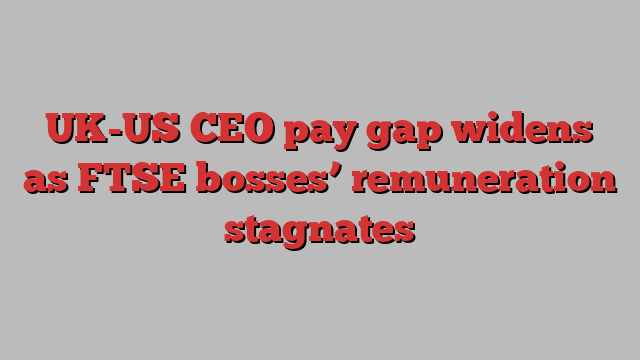
Unlock the Editor’s Digest for free
Roula Khalaf, Editor of the FT, selects her favourite stories in this weekly newsletter.
FTSE 100 chief executives’ pay stagnated at a median of £4.1mn last year, widening the gulf with US company bosses whose income is rising at the fastest rate in 14 years.
Median pay for the CEOs of the UK’s biggest listed groups flatlined, rising about £20,000, or 0.5 per cent, from the previous 12 months, according to analysis for the Financial Times by Willis Towers Watson.
The widening US-UK remuneration gap is likely to add fuel to a debate in the City of London over executive pay and whether UK-listed companies with a large international presence are able to attract top executives.
Corporate bosses, including the chair of the FTSE’s most valuable company AstraZeneca, have hit out at what they see as the overly restrictive approach to boardroom pay taken by some investors and the proxy agencies that advise them on whether to support companies’ remuneration policies.
The chair of one FTSE 100 company said that “one of the first things” headhunters said to him when he began looking for a new chief executive last year was that US-based candidates would be out of reach because of the limits on what UK companies can pay.
“For a low productivity economy to be saying to itself that we can’t have access to the best pool of managerial talent in the world — that seems to me an issue worth proper thought,” he added.
London Stock Exchange Group, online retailer Ocado and medical devices group Smith & Nephew, are among the leading London-listed companies to have pushed through increased pay packages for their executives this year despite opposition from some investors.
These changes were unlikely to have a big effect on median CEO pay in the short term, said Richard Belfield, leader of Willis Towers Watson’s European executive compensation practice. That was because they were introduced by only a handful of companies and most of the increase was in the form of long-term incentives, which would not be received by executives for years, he said.
Although the state has no role in regulating executives’ pay, company bosses have won political support from the current government. “I have no problem with high levels of executive pay if it is merited by the performance,” chancellor Jeremy Hunt told the Financial Times in an interview about attempts to revive the London stock market’s international competitiveness.
The latest figures show a continuing divergence between the UK and the US, where median chief executive pay rose 12 per cent in the 2023 financial year, according to proxy adviser Institutional Shareholder Services.
Chief executives on the S&P 500 index were paid a median of almost $16mn, ISS found.
The gulf between the UK and US is explained only partly by the larger size of the US’s biggest companies. The former chief executive of Smiths Group stands to roughly double his pay after quitting the FTSE 100 industrial conglomerate this year to take the same role at a US company half the size.
The analysis reflects executives’ total remuneration, including bonuses and share awards and is based on the 90 per cent of companies that have so far reported their figures for financial years ended since September 2023.
The CEO pay increase was a much lower rate than that of the wider UK workforce, whose average total earnings grew at an annual rate of 5.7 per cent, according to Office for National Statistics figures for the first quarter of 2024.